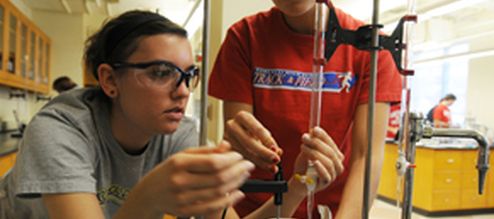Crystal Structures, Phase Transitions and Energy Calculations of Poly(p-phenylene) Oligomers
Document Type
Article
Publication Date
4-1993
Publication Source
Polymer
Abstract
The room temperature crystal structures, unit cell dimensions at 110K and phase transitions of three poly(p-phenylene) oligomers are reported. The structures of p-quinquephenyl (PQP), C30H22,p-sexiphenyl (PSP), C36H26, and p-septiphenyl (PSeptiP), C42H30, each belonging to space group P21/c, are similar to those of shorter oligomers. The unit cell dimensions are a = 22.056 Å, b = 5.581 Å, c = 8.070 Å and β = 97.91° for PQP, a = 26.241 Å, b = 5.568 Å, c = 8.091 Å and β = 98.17 ° for PSP, and a = 30.577 Å, b = 5.547 Å, c = 8.034 Å and β = 100.52 ° for PSeptiP. The a axis increases with molecular length. The molecules are linear and planar in all three structures. The herringbone nature of the packing is similar for PQP and PSeptiP, while a considerably greater tilt occurs in PSP. At 110K, the unit cell parameters b and c are approximately doubled while a remains nearly the same as in the room temperature cell. A time-dependent solid state transition is observed for PQP, PSP and PSeptiP when crystals are cooled to 110K. At elevated temperatures, thermal measurements indicate the oligomers to be thermotropic liquid crystals. The crystal-smectic transition temperatures are reported for PQP, PSP, PSeptiP and p-octiphenyl (POP), C48H34. The results of a molecular mechanics study on the conformation and packing of PSP are also presented. The competition between intramolecular forces (such as ortho hydrogen repulsions) and intermolecular crystal packing forces was examined in particular. Molecular mechanics calculations predict non-planar conformations in isolated polyphenyls, implying that conjugation between phenyl rings is insufficient to overcome ortho hydrogen repulsions. In a crystalline environment, however, intermolecular forces tend to force a planar conformation. Calculations on arrays of PSP molecules show that changing the phenyl-phenyl torsion angles from the coplanar value increases the total energy of the structure. The most favourable intermolecular interactions between oligomers are achieved for conformations having the phenyl rings coplanar.
Inclusive pages
1571–1587
ISBN/ISSN
0032-3861
Copyright
Copyright © 1993, Elsevier
Publisher
Elsevier
Volume
34
Peer Reviewed
yes
Issue
8
eCommons Citation
Baker, Kenneth N.; Fratini, Albert; Resch, Timothy; Knachel, Howard; and Adams, W. Wade, "Crystal Structures, Phase Transitions and Energy Calculations of Poly(p-phenylene) Oligomers" (1993). Chemistry Faculty Publications. 67.
https://ecommons.udayton.edu/chm_fac_pub/67
COinS



